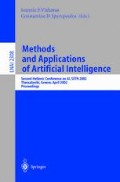Abstract
This paper presents a new method for defining and extracting visual landmarks for indoor navigation using a single camera. The approach considers that navigating from point A to point B amounts to navigating to intermediate positions, which are signified by recognition of local landmarks. To avoid the pose problem we seek scene representations that rely on clustered corners of physical objects on corridor walls. These representations are scale and translation independent and allow for the construction of a metric that can match pre-detected landmarks of a learning phase with landmarks extracted from images captured at run-time. The validity of our approach has been verified experimentally.
Access this chapter
Tax calculation will be finalised at checkout
Purchases are for personal use only
Preview
Unable to display preview. Download preview PDF.
References
S.M. Smith and J.M. Brady. SUSAN — a new approach to low level image processing. Int. Journal of Computer Vision, 23(1):45–78, May 1997.
P. Trahanias, S. Velissaris, S. Orphanoudakis, “Visual recognition of workspace landmarks for topological navigation”, Autonomous Robots, 7, 143–158, 1999.
Kampman, P. and Schmidt, G. Indoor navigation of mobile robots by use of learned maps, In “Information processing in Autonomous mobile robots”, Springer-Verlag, 1991.
Mataric, M. J. Integration of representation into goal-driven behaviour-based robots. IEEE Transactions on Robotics and Automation, 8(3), 1992
Kortencamp, D. and Weynmouth, T. Topological mapping for mobile robots using a combination of sonar and video sensing. In Proceedings of the AAAI, 1994
Kurz, A. Constructing maps for mobile robot navigation based on ultrasonic range data. IEEE Transactions on System, Man and Cybernetics, 26(2):233–242, 1996.
Chandrinos, K.V., Tsonis, V. and Trahanias, P. Automated Landmark Extraction and Retrieval, SIRS, Edinburgh, 1998
Carlo Tomasi and Takeo Kanade. Detection and Tracking of Point Features. Carnegie Mellon University Technical Report CMU-CS-91-132, April 1991
D. I. Kosmopoulos, K.V. Chandrinos, Technical Report DEMO2000/14, Athens, November 2000
S. Se. D. Lowe, J. Little, “Vision— based mobile robot localization and mapping using scale-invariant features”, International Conference on Robotics and Automation, Seoul, Korea, pp. 2051–2058, 2001
V.C. Verdiere, J. L. Crowley, “Local appearance space for recognition of navigation landmarks”, Robotics and Autonomous Systems, 31, pp 61–69, 2000.
N. Vlassis, Y. Motomura, I. Hara, H. Asoh, T. Matsui, “Edge-based features from omnidirectional images for robot localization”, International Conference on Robotics and Automation, Seoul, Korea, pp. 1579–1584, 2001.
P. Lamon, I. Nourbakhsh, B. Jensen, R. Siegwart, “Deriving and matching image fingerprint sequences for mobile robot localization”, International Conference on Robotics and Automation, Seoul, Korea, pp. 1609–1614, 2001.
L. Tang, S. Yuta, “Vision based navigation for mobile robots in indoor environment by teaching and playing-back scheme”, International Conference on Robotics and Automation, Seoul, Korea, pp. 3072–3077, 2001.
R. F. Vassallo, H. J. Schneebeli, J. Santos-Victor, “Visual servoing and appearance for navigation”, Robotics and Autonomous Systems, 31, pp. 87–97, 2000.
M. Mata, J. M. Armingol, A. Escalera, M.A. Salichs, “A visual landmark recognition system for topological navigation of mobile robots”, International Conference on Robotics and Automation, Seoul, Korea, pp. 1124–1129, 2001.
Author information
Authors and Affiliations
Editor information
Editors and Affiliations
Rights and permissions
Copyright information
© 2002 Springer-Verlag Berlin Heidelberg
About this paper
Cite this paper
Kosmopoulos, D.I., Chandrinos, K.V. (2002). Definition and Extraction of Visual Landmarks for Indoor Robot Navigation. In: Vlahavas, I.P., Spyropoulos, C.D. (eds) Methods and Applications of Artificial Intelligence. SETN 2002. Lecture Notes in Computer Science(), vol 2308. Springer, Berlin, Heidelberg. https://doi.org/10.1007/3-540-46014-4_36
Download citation
DOI: https://doi.org/10.1007/3-540-46014-4_36
Published:
Publisher Name: Springer, Berlin, Heidelberg
Print ISBN: 978-3-540-43472-6
Online ISBN: 978-3-540-46014-5
eBook Packages: Springer Book Archive

